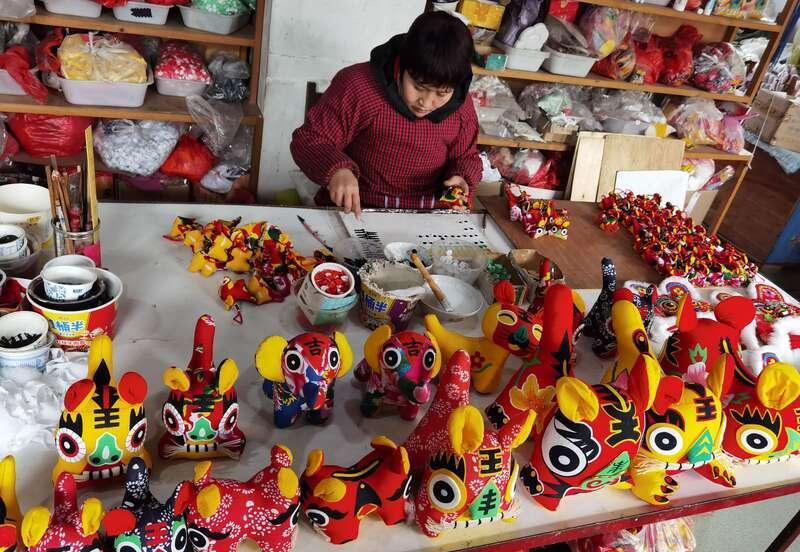Zhang Yan Kong Yawei, Reporter of China Youth Daily, China Youth Network Xing Ting
"I'm sorry, but our cloth tiger production is so limited that we can't deliver your order of 300 on time." In the southwest corner of a Qu village in The town of Xiqian in Qufu City, Niu Chenglu, the owner of the Fulin Folk Craft Workshop, once again refused a large order, and his words were full of apologies but very firm.
On the ninth day of the Chinese New Year, the new year flavor of a Qu village is still strong, and the big red lanterns outside the door of the Fulin Folk Craft Workshop are bright and festive. There is no hustle and bustle of the Year of the Tiger, and in the quiet workshop, 16 old craftsmen are focusing on making the "cloth tiger" in their hands, or sewing or sticking, or cutting or pasting.

"It takes full concentration to get the craft to have an aura. We carve more of the 'cloth tiger' as a work of art, preferring to sell less than lower the standard. Niu Chenglu said this was his obsession with "tiger culture."
Cloth tiger is a traditional Chinese folk craft that is widely spread in the folk. The tiger culture of Qufu has increased its cultural charm due to the influence of Confucius. The legend about Confucius "Fengsheng Tiger Raising Eagles and Fanning" influenced the surrounding villagers, and people often sewed old cloth into the shape of a tiger and placed it in their homes to avoid evil and ensure peace.
As a child, he used to wear tiger head shoes and tiger head hats sewn by his grandmother, and Niu Chenglu has been full of feelings for tiger image products since childhood.
"When I was 10 years old, I noticed that there were fewer and fewer children wearing tiger shoes around me, and I suddenly began to worry about the loss of my old craft." Looking back on the past, Niu Chenglu was full of emotions, and a small worry in a single thought turned out to be his life's work.
In 1998, Niu Chenglu graduated from high school and began his own "dream-chasing journey", and gradually took root in the cloth tiger industry. After years of research in the south and north, he has studied different styles and different meanings of cloth tigers across the country, and in the inheritance of pure handicrafts, he has innovated 12 kinds of "cloth tiger" shapes such as the spirited peaceful tiger, the well-behaved tiger with a cute attitude, and the enthusiastic happy tiger.
"Intangible cultural heritage must be innovated on the basis of inheritance in order to adapt to the development of the times and have more vitality." In the years of engaging in the cloth tiger industry, Niu Chenglu has been innovating in the inheritance and forming his own style, so that this traditional folk craft can be carried forward.
In 2009, Niu Chenglu returned to his hometown of Yizhangqu Village to open a Fulin Folk Craft Workshop, leading the villagers to jointly develop the cloth tiger business. For more than 10 years, the "Fulinbu Tiger" has not only become the intangible cultural heritage of Jining City, but also led more than 70 villagers to find employment at their doorstep.
"It's not interesting to be idle when you're older, and when I hear that the village has started to get this cloth tiger, I was the first to sign up." Since I was a child, I will do needlework, get started quickly, do this to play our strengths, and make some money. The 76-year-old Wang Zhongjin is the oldest craftsman here and has been working in the craft workshop for 9 years.
Due to his old age, the old man Wang Zhongjin's ability to thread needles has decreased, and he is now specifically responsible for the cotton stuffing process. The seemingly simple link actually requires accurate pinching of the amount of cotton used in each part. For a cloth tiger the size of a duck egg, the cotton that needs to be stuffed into it is necessary to fill a bowl, which takes 5-6 minutes until the whole cloth tiger is hardened.
"The essence of cloth tiger is that the selection of materials is pure and natural, and the craftsmanship is pure handmade. Take this cotton stuffing process, if you use a cotton loader to fill, the yield is about four times higher. But the effect is different, and it does not show a vivid tiger shape. More importantly, the meaning of craftsmanship inheritance is gone. Niu Chenglu said bluntly.
With the continuous improvement of the popularity of "Fu lin bu tiger", the sales channels have become more and more extensive, and the output has reached more than 20,000 per month, but it is still far in short supply. Many people have suggested to Niu Chenglu: Take advantage of the Year of the Tiger, and do not want to find a way to put on equipment, simplify the process of mass production, and seize the good opportunity to get rich. Niu Chenglu is as determined as the more than 70 craftsmen in the workshop: he would rather sell less than make up the number!
"My biggest goal is to pass on this craft, not just for the sake of economic benefits, but also to take into account the uniqueness of intangible cultural heritage handicrafts." In Niu Chenglu's view, using the "workshop + farmer" model to slowly increase production and let more non-hereditary inheritors participate is the best way out for Buhuhu.
Source: China Youth Daily client